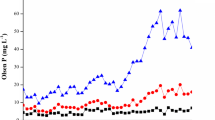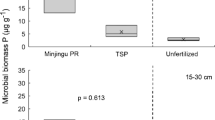Abstract
Reactive phosphate rocks (RPRs) from Sechura, Peru (SPR) and North Carolina, USA (NCPR) were compared with triple superphosphate (TSP) as phosphate (P) fertilizers for permanent grass/clover pastures in four field trials in New Zealand. Trial sites ranged in initial pH (in water) from 5.7 to 6.3 and in rainfall from 712 to 1338 mm yr−1. SPR and NCPR were used in the unground ‘as-received’ state. Fertilizers were applied annually for six years. Pasture was harvested by frequent mowing, and herbage dry matter (DM) yields were measured at each cut. Herbage P concentrations were measured at each cut in two trials and on most cuts in the other two.
For all sites combined, DM production from RPRs was initially significantly less than from TSP but it improved relative to TSP with time. Substitution values of RPR relative to TSP, denoted by S.V. (TSP/RPR) and defined as the ratio of P in TSP to P in RPR required to produce the same plant response during a specified period of time, were estimated by relating yields from RPR treatments to the yield response curve for different application rates of TSP. For the four trials combined, S.V. (TSP/SPR) increased from 0.32 in year 2 to 0.85 in year 6. S.V. values for NCPR were similar. The site which had the lowest S.V. values (average 0.20) for total production over six years was the site with highest pH (6.3) and lowest rainfall (712 mm). Corresponding S.V. values for the other sites were 0.50 to 0.78.
Herbage P concentrations showed a similar pattern of RPR performance relative to TSP to that shown by DM production except at the highest application rate where TSP always supported much higher herbage P concentrations than RPR.
The pattern of DM production from RPR relative to TSP was explained on the basis of a model involving soil P pools of undissolved fertilizer P and plant-available P respectively, with the hypothesis that P dissolved from RPR entered the plant-available P pool and was used with the same efficiency as P entering by dissolution of TSP. Model predictions of substitution values using directly measured RPR dissolution rates agreed well with observed substitution values.
The advantage of RPRs in comparison to soluble P fertilizers for permanent pastures was considered to lie in their lower price and not in greater nutrient efficiency. Economic advantage was calculated in terms of the return on investment from establishing and maintaining a pool of RPR in the soil large enough to release the required annual amount of plant-available P compared with the cost of annual applications of soluble P fertilizer.
Similar content being viewed by others
References
Aguilar SA and van Diest A (1981) Rock phosphate mobilisation induced by the alkaline uptake of legumes utilising symbiotically fixed nitrogen. Plant Soil 61: 27–42
Bolan NS, White RE and Hedley MJ (1990) A review of the use of phosphate rocks as fertilizers for direct application in Australia and New Zealand. Aust J Expl Agr 30: 297–313
Bolland MDA and Barrow NJ (1988) Effect of level of applications on the relative effectiveness of rock phosphate. Fert Res 15: 181–192
Chien SH, Sale PWG and Friesen DR (1990) A discussion of the methods for comparing the relative effectiveness of phosphate fertilizers varying in solubility. Fert Res 24: 149–157
Cornforth IS and Sinclair AG (1982) Model for calculating maintenance phosphate requirements for grazed pastures. NZ J Exp Agr 10: 53–61
During C (1971) Fertilizers and Soils in New Zealand Farming. 2nd Ed., Government Printer, Wellington, New Zealand
Edmeades DC, Watkinson JH, Perrott KW, Sinclair AG, Ledgard SF, Rajan SSS, Brown MW, Roberts AH, Thorrold BT, O'Connor MB, Floate MJS, Risk WH and Morton J (1991) Comparing the agronomic performance of soluble and slow release phosphate fertilizers: the experimental basis for RPR recommendations. Proc NZ Grasslands Assoc 53: 181–190
Johnstone PD and Sinclair AG (1991) Replication requirements in field experiments for comparing phosphate fertilizers. Fert Res 29: 329–333
McCall DG and Thorrold BS (1991) Fertiliser history is a useful predictor of soil fertility status. Proc NZ Grasslands Assoc 53: 191–192
Khasawneh FE and Doll EC (1978) The use of phosphate rock for direct application to soils. Adv Agron 30: 159–206
Perrott KW (1992) Effect of exchangeable calcium on fractionation of inorganic and organic soil phosphorus. Commun Soil Sci Plant Anal 23: 827–840
Probert ME (1985) A conceptual model for initial and residual responses to phosphorus fertilizers. Fert Res 6: 131–138
Quin BF and Scobie GM (1985) Getting the best return from fertiliser expenditure. Ruakura Farmers' Conference (New Zealand): 42-54
Rajan SSS, Fox RL, Saunders WMH and Upsdell M (1991) Influence of pH, time and rate of application on phosphate rock dissolution and availability to pastures. 1 Agronomic benefits. Fert Res 28: 85–93
Rajan SSS, Gillingham AG, O'Connor MB, Percival NA and Gray MG (1987) Ground phosphate rock as fertilizers for pastures. In: White RE and Currie LD (eds) The Use of Reactive Phosphate Rocks and their Derivatives as Fertilizers, pp 78–83. Massey University, Palmerston North, New Zealand
Saunders WMH (1965) Phosphate retention by New Zealand soils and its relationship to free sesquioxides, organic matter, and other soil properties. NZ J Agric Res 8: 30–52
Sinclair AG (1982) The agronomic availability of fertilizer phosphate. Proc 7th Research Symposium, NZ Fertiliser Manufacturers' Research Association: 1-8
Sinclair AG, Boswell CC, Cornforth IS, Lee A, Morgan, C, Morton J, Nguyen L, Saunders WMH, Shannon P, Smith RG and Whelan G (1985) Agronomic requirements for sulphur in New Zealand pastures. Proc 20th Technical Conference, NZ Fertiliser Manufacturers' Research Association, Volume 2: 538–583
Sinclair AG, Shannon PW and Risk WH (1990) Sechura phosphate rock supplies plant-available molybdenum for pastures. NZ J Agric Res 33: 499–502
Watkinson JW and Perrott KW (1993) Modelling pasture production with the dissolution of reactive phosphate rock in soil. Proc XVII International Grassland Congress: In press
Author information
Authors and Affiliations
Rights and permissions
About this article
Cite this article
Sinclair, A.G., Johnstone, P.D., Smith, L.C. et al. Agronomy, modelling and economics of reactive phosphate rocks as slow-release phosphate fertilizers for grasslands. Fertilizer Research 36, 229–238 (1993). https://doi.org/10.1007/BF00748701
Received:
Accepted:
Issue Date:
DOI: https://doi.org/10.1007/BF00748701




